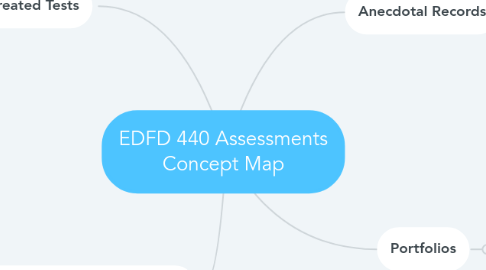EDFD 440 Assessments Concept Map
by Bailey H

1. Teacher-Created Tests
1.1. definition: assessments created by the teacher
1.2. why I will use it: flexible and personalized to the school/classroom content, to create assessments more beneficial and accurate than already-made ones, to ensure all standards are being met/addressed
1.3. how I will use it: I will at times create my own assessments (if allowed by the district or other team teachers). I can make these using google or Microsoft applications, then grade them like normal. I will refer to recent lessons and assignments, as well as standards, to create the tests.
1.4. formative examples: exit tickets, number head folders, etc.
1.5. summative examples: rubrics, checklists, tests and quizzes (multiple choice, matching, short answer, fill the blank, etc.
2. Curriculum Based Measurement
2.1. definition: an assessment lasting a few minutes given regularly throughout the school year that measures students skills in different academic subjects such as math, reading, and writing
2.2. why/how I will use it: usually required, discover how to help students improve/how to improve instruction, to track students progress, fast and easy to give, to communicate results with parents and administrators
3. Anecdotal Records
3.1. definition: notes teachers take to record observations about students learning or behavior
3.2. why I will use it: to identify instructional or behavioral concerns and needs of students; to use for communicating with parents; to plan future instruction and intervention
3.3. how I will use it: I think a note card system would work well. I will write my observations on one notecard per day (or more if needed) for each student I need to do this for, then file them in something like a recipe box. I could later refer to them when I contact parents or other faculty with concerns so I can provide specific evidence and details. I might also transfer what is written on these note cards onto a computer document when the box gets full so that I can always access it.
4. Portfolios
4.1. definition: collection of students work that represents their performance
4.2. why I will use it: to refer to past student work, to see if/how the student is improving in different academic areas, to communicate with/provide evidence for parents and administrators (parent teacher conferences, questions from administration or other faculty, etc.)
4.3. how I will use it: Throughout the year, I will collect certain assignments and assessments for each student which I add to their individual portfolios. Each student will have a different folder as their portfolio, stored either in a bin or in a filing cabinet. I will get the portfolios out as needed to reflect on instruction or communicate with others.


